| Gene
Markopoulos
Some Observations on “Spring Cactus” (Zheng qing kuang
ai) – A Film by Yu-Shan Huang
What makes a feminist filmmaker like Huang Yu-shan turn
to the factual story of a young girl or rather, a very young woman whose
story makes the headlines because she was involved in juvenile delinquency,
later on became a prostitute, and finally committed suicide at age 28?
Is it a empathy? Is it anger, directed at a society still embracing too
many patriarchal values, a society largely dominated by men? Of course
you encounter them on every level, as teachers, preachers of morality,
journalists, judges, cops, customers of brothels and pimps. Spring
Cactus (Zheng qing kuang ai) is the “true story” – we are told
– of Chen Ai-Lan. And we are also informed that the film was “made possible”
only “after a few years of field investigation.”
As so often in such cases, the protagonist of the film
is raised in a family where problems abound. Soon, she is also taken
for a problem child. While still in high school, a sentimental love develops
between her and Xiao Lin, who is seen by adults as quite the opposite of
this ‘saucy’ girl, an exemplary student, so to speak.
As would be typical for any romantic melodrama, their
friendship faces the resistance of a world of righteous adults. It is Xiao
Lin’s parents who are the most concerned; they turn to a teacher, expressing
their fear that the girl is a ‘rotten apple’ who might have a bad effect
on their son. When the two young people find it impossible to factually
continue their friendship, the boy kills himself and the girl runs away
from home. Out on her own in the city, she encounters Chen Mingdao, a young
man who is doing social work, as a candidate of a Buddhist order which
he aspires to join, as a monk. But bye-bye, chastity and existence as a
monk. The two get married. A marriage of very different persons, it seems
– so conflicts must erupt, perhaps. One day, in a fit of anger or impatience,
the girl attacks and wounds Ming-dao badly. She is imprisoned. On her own
in the city again, after having served time. Yes, she meets a guy who is
willing to “protect” her. She walks the streets, she smokes, drinks, takes
drugs. And yet she is tender. Cannot even refuse a beggar’s plea for money.
But the guy who “protects” her is no good. Is there ever a pimp who is
good, who does not beat up his girl? We can almost predict that the day
is not far when she attacks and kills him. Again, she lands in jail. Out
of jail again, this time it is Blacky whom she encounters soon after she’s
left jail. Blacky belongs to the dark world of the city, too – he’s a gambler
and bad-tempered, at that. Her life gets darker and more confused, as she
tries to make a living, as a prostitute, supporting herself and Blacky’s
gambling habit. Then, strange coincidence, she chances upon Cheng, a Buddhist,
known as a Dharma Master. Is it superstition? Is it the chance moment the
surrealists celebrated? Something in this encounter seems to have made
a difference, or so we are briefly lead to believe. For all of a sudden
the protagonist knows she wants something else. She’ll stop taking
drugs, she tells herself. She will be a different person, living a different
life. Starting truly from scratch, she wants to shake off the past. But
soon we learn that the peace of mind she found briefly, and the inner purity
that survived in her have no chance to persist in society as it is. The
world of the righteous ones, the hypocrites, the respectable people does
not forget whom it has cast aside. No Buddhist salvation, no mercy is possible.
And the righteous ones will always have their counterparts and willing
helpers in the dark world. When the female anti-heroine, our tender, rebellious
protagonist, attempts to begin a new life with Xiao Mao, a guy she encountered
and befriended while in jail, she is betrayed. Having lost all hope that
a turn-about, a new life, is possible, she takes her life, in a final gesture
of protest and rebellion.
Huang Chung-ming, in his short story Sayonara Zaijian
dwelled on the topic of prostitution in Taiwan many years ago. That it
is a social issue to deal with, and one that must get feminists on the
barricades, is clear to anybody who has seen the teenage girls working
in the many “barber shops” of small towns like Tamshui, of harbor towns
like Keelung and Kaohsiung, and of the various villages by the sea that
are inhabited by fishermen and their families. Of course, there are also
the luxurious whores loitering in the lobbies of five star hotels in Taipei.
Or in Yangminshan – that spa in the mountains above Taipei, so well-known
for its hot sulphor springs. But that is another story, as is the story
of the college girls who work as escorts in ‘dance halls.’
Huang Yu-shan’s film is remarkable for a number of reasons.
One of them is the filmic language she has found in order to narrate this
seemingly simple, melodramatic story that seems so full of romantic stereotypes,
at least from the point of view of the male chauvinist skeptic.
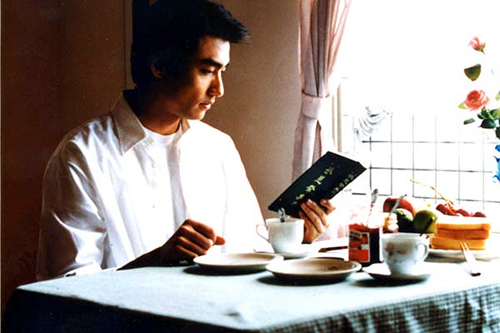
Xiao Lin
The shots are well-composed, to begin with. Look at the
still that shows Xiao Lin at the breakfast table, ignoring both fruit and
toast, the dish clean because he hasn’t eaten anything, the jar filled
with jam untouched. It is a Western breakfast, not a traditional Chinese
one. Probably he drinks coffee instead of tea. The expression of his face
is earnest yet not stiff. At ease with himself, he fully concentrates on
the book he is reading. No voice over, no narrator is necessary to tell
us what kind of person he is. A good son, a sensitive person, dedicated
to a world of books, a world of ideas. A vulnerable person, not the typical
slick yet rough male who succeeds in the “world outside”. So little, carefully
selected, is needed to tell so much in a single shot. But do you notice
the spatial dynamism of this image? The diagonal position of the table,
and the way, therefore, in which Xiao Lin is facing us? In fact, his chest,
in that white shirt, is catching our attention. The face looks away from
us, a little slanted, directed with great intensity, at the page of the
book. Are the colors telling us anything? There is so much whiteness, so
much light, contrasted by the darkness of an edge or section of the table
cloth, the black of the book cover, the warm pastose red-brown of the wall
in the back of the young man. In the West, we know, light was sometimes
taken as a symbol of enlightenment. And here? Maybe, too.
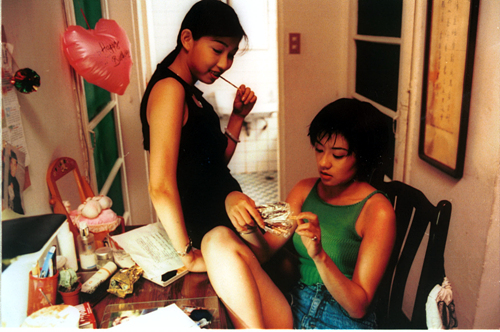
Ai-Lan and another girl
Here, we see the crammed room of the female protagonist
who ekes out a living as a whore in order to survive in the city.
There are the paraphernalia of a teenager’s life. In a brothel? Yes,
in a brothel, too. A red heart saying “Happy birthday”. A mirror. Other
small items which will make men wonder what they mean or what use they
may have. The girls are talking. About boys? About hopes harbored? How
pensive the heroine is, as she looks at that item she holds in her hands.
And how intensely the atmosphere of a small, crammed room in a whorehouse
has been recreated. But don’t kid yourself – a room in a students’ dorm
would not look different perhaps. And these girls are not different from
the girls who are not forced by circumstance to sell themselves.
The mirror again! Azed Yu, in her fine text on the films
of Huang Yu-shan, has already pointed out how significant they are. The
symbol of self-awareness of young women like Ai-Lan?
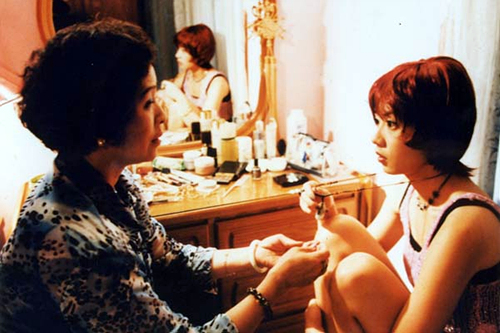
The madam and Ai-Lan
Again, the composition of the image is superb. How much
sensitivity is needed to attain this interplay of a space filled by two
persons, a space visible in front of and then, in a mirror!
There is the older woman, a stalwart of the oppressive, sexually exploitative
“male world”. How stern she looks, in her elegant, almost traditional
Chinese dress that could have been worn already in the more expensive whorehouses
of Shanghai in the 1930s, by such a stern looking madam. The dress fully
covers her, except for the hands, the throat, the face. And the darkness
of its pattern underscores this impression. Facing her, there is the young
girl. With her nude arms, her nude legs raised high as she draws the knees
close to her body, she seems to be almost naked. Does she look as if at
a loss? Frightened? Or asking for something? Help that she cannot get?
A life line? In the mirror, she looks more adult, cooler, but also very
much on her own. The madam is not mirrored.
In the mirror that projects the small, distant image of
the girl, we discover darkness, but also white curtains and the light entering
through that window which must exist behind these curtains. Reduplicated,
the curtains that cover the window exist as well right behind Ai-Lan. Do
they separate her from something, do they make her appear like a bird in
a cage, inside this room? Do they keep out a different, and perhaps also
freer world?
Thanks to the window behind those flimsy curtains, the
right side of the image (the side of the girl !) is flooded by light. The
darkness is seated opposite her. Is that symbolic?
The piece of furniture in front of and underneath the
mirror is positioned diagonally, which enhances the spatial dynamics of
the image. The colors are by and large warm and aglow, contributing to
the impression of an almost luxurious boudoir or a dressing room. As she
stares at the madam, the girl, Ai-Lan, clasps what seems to be a medallion
on a chain, stretching the chain. It is as if she is a little pig or a
lamb with a rope around the throat. Torn towards the master and butcher.
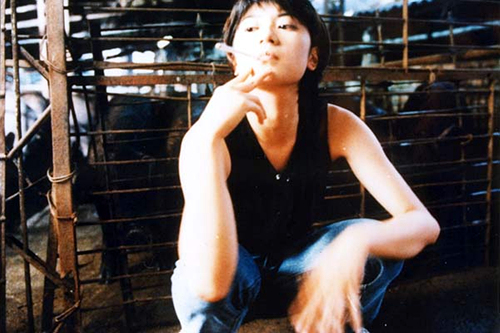
Ai-Lan
I rarely saw such loneliness, such lostness in a single
instant. Out in the cold night of the city, in some place where animals
seem to be kept in cages, she squats and smokes a cigarette in front of
the grid pattern of the cage.
It could well be that she is imprisoned and that the others
are outside the cage, I thought for a moment. But of course, she is outside,
on her own. Living her existential freedom, her lonely revolt en route
to defeat and doom. A lost, deserted yet lovely and lovable person. Her
face full of loneliness. No illusions any more. No hope or not much
of it that is left.
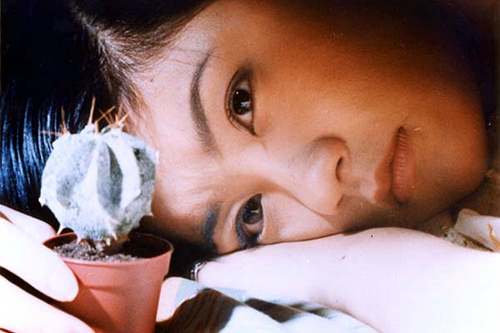
Ai-Lan and the small cactus flower
“She was like a cactus left in the desert to flower,”
Bae Doo-Rye said. Yes, indeed. Azed Yu pointed out how the filmmaker, Huang
Yu-shan, introduces such symbols as the cactus, visible in this shot, again
and again in her entire oeuvre. I would underline the non-symbolic presence
of the face, of its expression that is both sad and tender, close to or
already beyond the point of utmost despair. How tenderly she holds and
looks at this small living plant. A tender, lovable plant – if we accept
that it needs spikes that sting.
Yes, it is true – in creating this film, Spring
Cactus, Huang Yu-shan has created a sentimental melodrama, full
of clichés, if we just concentrate on the story line, the script,
in fact. But each sequence and each shot gives us a cosmos, a small human
universe full of closely observed details and alive with genuine emotions.
Is the film uncritically reproducing conventional notions?
I don’t think so. It picks up such notions in order to deconstruct them.
The saucy, bad girl is rebellious for a reason, and if not almost pure
at heart, then at least sensitive, vulnerable, filled with a sense of justice,
which explains why she explodes, in certain situations, not being able
to take any more what men do to her. The Dharma Master, and thus Buddhism,
does not bring enlightenment and salvation – even though the empirical
reality that sensitive Buddhists exist is not denied. But they are as helpless,
vis-à-vis the society they encounter, as this sexually exploited
young woman.
As Bae Doo-Rye noted already, idealistic exhortations
are impotent in our modern, male-dominated, market-oriented society
today where everyone and everything can be bought for money. And so, “Mingdao’s
parting words, that no one can change you but yourself, seem rather unconvincing
when institutions like school or family turn a cold shoulder and society
hands her a pair of handcuffs while demanding of her to ‘come to her senses.’”
(Bae Doo-Rye)
In an unobtrusive way that avoids everything overly pithy,
the film gets this across. And this, in addition to its close and intimate
observation of people and situations, its careful composition, is a great
achievement.
If I have called Spring Cactus a melodrama,
let’s not forget that Fassbinder also created many films that are aptly
called melodramas.
(April 2011)
Spring Cactus, directed by Huang Yu-Shan, Taiwan, China (1999),
35mm, color, 105’
Screenplay by He Hsin-Ming and Huang Yu-Shan
Cast: Chia Ching-Wen [Jia Jing-Wen], Hu Ping [Hu Bing], Lin Li-Yang,
etc.
Cinematography: Chang Chih-Yuen
Sound: Liao Chi-Hua
Editing: Huang Yu-Shan
Music: Chen Shin-Hsing
Production Designers: Yao Yo-Shun, Tang Yi-P
Producers: Chang Shih-Kun, Shu Tzu-Hao, Huang Yu-Shan ?
Produced by Hsing Lee and King Ho, Huang Chen ?
Executive producer. Shih Hun Chang
Distributed by: Taiwan Film Culture Company and
B & W Film Studio
|